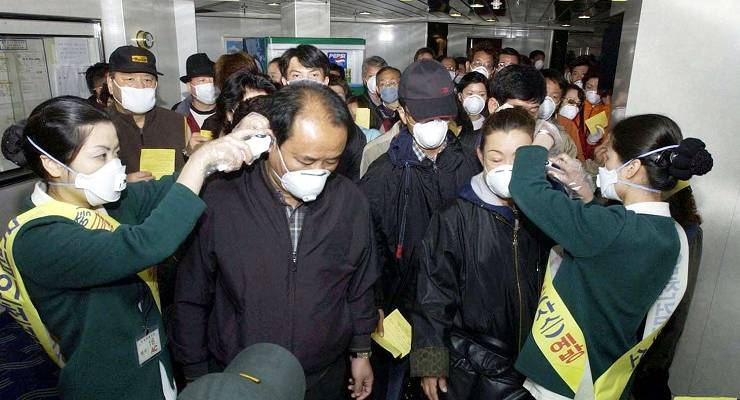
At least 300 people have been infected by the new coronavirus in China, sparking panic as millions travel to celebrate the Lunar New Year.
From swine flu to Y2K, the world loves to stress about prophecies and plagues. Crikey takes a look at other notable outbreaks, and how we dealt with them.
Swine flu
Swine flu panic spread across the world faster than the virus itself. Compared with the 1918 Spanish Flu pandemic, the H1N1 influenza virus was predicted to infect up to 2 billion people, with one report estimating 10,000 Australians would die in New South Wales alone.
A vaccine was quickly developed and the Australian government panicked, dropping more than $100 million on vaccines (though it only distributed around half of them).
In reality, the disease was much less severe. WHO was criticised for prematurely declaring a pandemic, though swine flu is estimated to have claimed the lives of between 105,000 and 395,000 people across the globe, and between 191 and 1600 in Australia. Awful, but not much worse than a bad flu season.
Y2K
We can laugh about it now but, at the time, people were seriously panicked about the “Millennium Bug”. Computer programs only had a two-digit code for the year, leading the public to panic that when we ticked over into the new millennia, there would be a major glitch.
Y2K prophets saw planes falling out of the sky, global blackouts, world economic recessions as banks calculated interests rates minus 100 years, and nuclear explosions as incorrect calculations changed water pressure and radiation levels.
Instead, we entered the century feeling pretty silly about ourselves.
Smallpox
Now eradicated, smallpox was once one of the world’s deadliest diseases. In 1789, the disease decimated Australia’s Aboriginal population, killing thousands. The colonists were unaffected, thought to have built up an immunity. It’s possible this was an act of biological warfare.
Zika
In 2016, our screens were flooded with heartbreaking photos of crying babies with tiny heads as an outbreak of the Zika virus spread across the Americas. The world reacted: there were calls to cancel the Summer Olympics in Rio de Janeiro, postpone planned pregnancies, and for tourists to stay away from affected areas.
Zika fell away from national headlines; because the mosquitoes that carry the disease can only survive in far-north Queensland, the panic was easily mitigated in Australia.
While the outbreak officially ended in November 2016, there is no vaccine, placing millions still at risk.
Ebola
Rare but severe, the Ebola virus disease hit headlines in 2014-16 and again in 2018 when the largest outbreak since its discovery spread across west Africa. Transmitted through broken skin and body fluids, the disease doesn’t die when its host does. It kills about half of all those infected.
While images of workers dressed in radioactive yellow dominated our airwaves for a few days, Australia quickly developed empathy fatigue for the illness; the risk is low for us. A trial vaccine is being developed, and the disease has been largely contained.
Mayan 2012
The end of the world was supposed to happen eight years ago. An ancient Mayan calendar system only cycled up to 2012 (a mere 200,000 years into the future). It was predicted the solar system would be sucked into a black hole, collide with another planet and destroy us all.
Cosmic imagery but, obviously, we’re all fine.
SARS
Severe Acute Respiratory Syndrome (SARS) appeared in China in 2002, prompting Australia to implement tough border control and new laws to isolate infected people against their will.
In the end, the virus didn’t land on our shores — but not before the outbreak killed 800 people across Asia.








Your inclusion of the Y2K bug on this list is daft, and not at all helpful. We avoided the so-called “bug” because tens of thousands of people in IT spent the better part of two years re-engineering systems and providing workarounds. It wasn’t a fizzer by accident.
Y2K bug — bit like climate catastrophe 🙂 ?
Climate catastrophe ? What ? So many fields of science collecting data & analysing and coming up with pretty predictable consequences .And then spreading the news like a plague to panic the natives ? For what purpose ? for what gain ? So many questions could try to obfuscate and deflect the various science disciplines into just a bit of a bug in the system..
Yes, in that it only won’t happen if we take action to fix it.
The time has passed for lame trolling over climate change Desmond.
Sure there was some opportunistic rorting, but the differences are quite instructive.
Y2K: Identify problem, analyze, formulate solutions, implement, fix
Climate: Identify problem, analyze, formulate solutions, mass science denial, catastrophe.
‘Instead, we entered the next century feeling pretty silly about ourselves.’
Happily, we got over it.
Agreed AFAF. The Y2K inclusion in this piece was just plain lazy. You’re better than that Amber.
While many claims about Y2K were alarmist and incredible there was a problem and millions of lines of computer code was changed in the 3 years or so prior to the dread date which was the main reason why nothing happened. So much money was spent that there was a recession in the computer services business in the 2 years after 1/1/200.
Yes, and lots of large companies, including the one for which I worked, took the opportunity to replace patchy software which had been developed ad hoc over the preceding decades with integrated, Y2K compliant applications. There was a lot of money spent, and lots of retraining, but the change produced business efficiency benefits far beyond just the avoidance of Y2K issues.
Yet again an ignorant commentator refers to the ‘Millenium Bug’ as being a non-existent problem. This is absolutely untrue. Many tens of millions of dollars were expended on real project teams of real programmers fixing the date handling algorithms of vast numbers of software systems.
My own organisation fixed the main data processing systems of a major health systems provider, and two large energy companies. The task involved changing the format of the specific database fields holding dates, copying all of the data from the old database structures into the new ones, and recasting all of the processes using those dates. This was a major operation, and its success can be measured by the fact that very few serious glitches occurred in critical systems.
The bugs were there, and they were eliminated by major corrective action.
A facile comparison – biological and virtual viruses are utterly different phenomena, though the misinformation and panic that are engendered (usually for political purpose) are similar.
Two examples:
SARS CoV devastated the Ontario medical system not by it’s transmission between humans (which was limited to the initial mutation in Southern China), but by the hysterical fear of contagion that saw health care workers identified, evicted and shunned in communities. Recruiting to Toronto took a decade to recover.
The real reason Gulf War 1 was delayed was that the Coalition forces needed at 4 weeks to vaccinate the invasion against smallpox virus (which Saddam Hussein did not have) as well as Anthrax (which he did have). The Yanks vaccinated their forces without informed consent (and lost more to the vaccine reactions than to enemy fire). The Poms insisted on informed consent – and right to refuse.
Try fixing that with code.